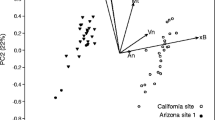Abstract
Western pine beetles were caught on unbaited sticky traps placed near a source ofexo-brevicomin, frontalin, and myrcene. Size of trap, distance and direction from the source of attractant, and height from the ground were varied. Significant differences in trap catch were observed in relation to each of the variables. Traps close to the source of attractant caught more beetles than traps farther from the source. Traps downwind of the source of attractant caught more beetles than did upwind traps. More males than females were trapped close to the source of attractant.
Similar content being viewed by others
References
Aylor, D.E., Paslangef, J., andGranett, J. 1976. Turbulent dispersion of disparlure in the forest and male gypsy moth response.Environ. Entomol. 5:1026–1032.
Bedard, W.D., andBrowne, L.E. 1969. A delivery-trapping system for evaluating insect chemical attractants in nature.J. Econ. Entomol. 62:1202–1203.
Bedard, W.D., andWood, D.L. 1974. Programs utilizing pheromones in survey and control: Bark beetles—the western pine beetle, p. 441–449,in M.C. Birch (ed.). Pheromones. North-Holland, Amsterdam.
Chapman, J.A. 1962. Field studies on attack flight and log selection by the ambrosia beetleTrypodendron lineatum (Oliv.) (Coleoptera: Scolytidae).Can. Entomol. 94:74–92.
Coster, J.E., andGara, R.I. 1968. Studies on the attack behavior of the southern pine beetle. II. Response to attractive host material.Contrib. Boyce Thompson Inst. 24:51–66.
Gara, R.I. 1963. Studies on the flight behavior ofIpsconfusus (LeC.) (Coleoptera: Scolytidae) in response to attractive material.Contrib. Boyce Thompson Inst. 22:51–66.
Gara, R.I., Vité, J.P., andCramer, H.H. 1965. Manipulation ofDendroctonus frontalis by use of a population aggregating pheromone.Contrib. Boyce Thompson Inst. 23:55–66.
Goeden, R.H., andMorris, D.M. Jr. 1964. Attraction ofScolytus quadrispinosus (Coleoptera: Scolytidae) toCarya spp. for oviposition.Ann. Entomol. Soc. Am. 57:141–146.
Kellogg, F.E., Frizel, D.E., andWright, R.H. 1962. The olfactory guidance of flying insects. IV. Drosophila.Can. Entomol. 94:884–892.
Kennedy, J.S. 1977. Olfactory responses to distant plant and other odor sources, p. 67–91,in H.H. Shorey and J.J. McKelvey, Jr. (eds.). Chemical Control of Insect Behavior. John Wiley and Sons, New York.
Koerber, T.W. (compiler). 1976. Lindane in forestry ... a continuing controversy. U.S. Forest Serv. Pacific Southwest Forest and Range Expt. Sta. Gen. Tech. Rep. PSW-14. 30 pages.
Lanier, G.N., Silverstein, R.M., andPeacock, J.W. 1976. Attractant pheromone of the European elm bark beetle (Scolytus multistriatus): Isolation, identification, synthesis, and utilization studies, p. 149–175,in J.F. Anderson and H.K. Kaya (eds.). Perspectives in Forest Entomology. Academic Press, New York.
Lehmann, E.L. 1975. Nonparametrics: Statistical Methods Based on Ranks. Holden-Day, Inc., San Francisco, 457 pages.
McMullen, L.H., andAtkins, M.D. 1962. On the flight and host tree selection of the Douglas-fir beetle,Dendroctonus pseudotsugae Hopk. (Coleoptera: Scolytidae).Can. Entomol. 94:1309–1325.
Miller, J.M., andKeen, F.P. 1960. Biology and control of the western pine beetle. U.S. Forest Serv. Misc. Publ. 800. Washington D.C. 381 pages.
Miller, R.G. 1966. Simultaneous Statistical Inference. McGraw-Hill Book Co., New York. 272 pages.
Person, H.L. 1931. Theory in explanation of the selection of certain trees by the western pine beetle.J. For. 29:696–699.
Rudinsky, J.A. 1963. Response ofDendroctonus pseudotsugae Hopkins to volatile attractants.Contrib. Boyce Thompson Inst. 22:23–38.
Rudinsky, J.A. 1966. Host selection and invasion by the Douglas-fir beetle,Dendroctonus pseudotsugae Hopkins, in coastal Douglas-fir forests.Can. Entomol. 98:98–111.
Seybert, J.P., andGara, R.I. 1970. Notes of flight and host-selection of the pine engraver,Ips pini (Coleoptera: Scolytidae).Ann. Entomol. Soc. Am. 63:947–950.
Tate, N.L., andBedard, W.D. 1967. Methods of sexing live adult western pine beetles.J. Econ. Entomol. 60:1688–1690.
Traynier, R.M.M. 1968. Sex attraction in the Mediterranean flour moth,Anagasta kühniella: Location of the female by the male.Can. Entomol. 100:5–10.
Tukey, J.M. 1962. The future of data analysis.Ann. Math. Statist. 33:1–67.
Vité, J.P., andGara, R.I. 1961. A field method for observation on olfactory responses of bark beetles (Scolytidae) to volatile materials.Contrib. Boyce Thompson Inst. 21:175–182.
Vité, J.P., andGara, R.I. 1962. Volatile attractants from ponderosa pine attacked by bark beetles (Coleoptera: Scolytidae).Contrib. Boyce Thompson Inst. 21:251–273.
Wood, D.L. 1972. Selection and colonization of ponderosa pine bark beetles, p. 101–117,in H.F. Van Emden (ed.) Insect/ Plant Relationships; Symposia of the Royal Emtomol. Soc. of London, No. 6. Blackwell, London.
Wood, D.L., Browne, L.E., Ewing, B., Lindahl, K., Bedard, W.D., Tilden, P.E., Mori, K., Pitman, G.B., andHughes, P.R. 1976. Western pine beetle: Specificity among enantiomers of male and female components of an attractant pheromone.Science 192:896–898.
Author information
Authors and Affiliations
Additional information
Based in part on a thesis submitted by the senior author to the University of California, Berkeley, California, in partial fulfillment of the requirements for the degree Master of Science in entomology, December 1976. These studies were supported by the U.S. Forest Service and in part by the Rockefeller Foundation and a joint grant (NSF GB-34718/BMS 75-04223) from the U.S. National Science Foundation and the U.S. Environmental Protection Agency to the University of California. The findings, opinions, and recommendations are not necessarily those of the University of California or the funding agencies.
Trade names and commercial enterprises or products are mentioned solely for information and do not constitute endorsement by the U.S. Department of Agriculture or University of California.
Rights and permissions
About this article
Cite this article
Tilden, P.E., Bedard, W.D., Wood, D.L. et al. Trapping the western pine beetle at and near a source of synthetic attractive pheromone Effects of trap size and position. J Chem Ecol 5, 519–531 (1979). https://doi.org/10.1007/BF00987837
Received:
Issue Date:
DOI: https://doi.org/10.1007/BF00987837




